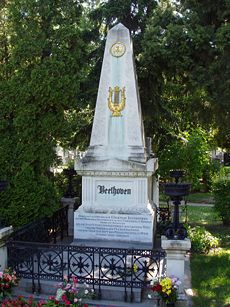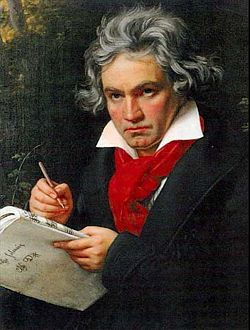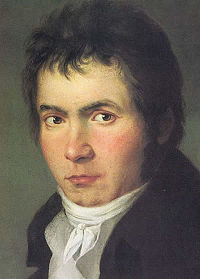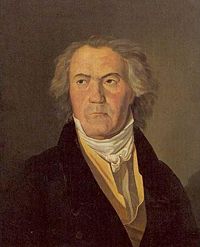Ludwig van Beethoven
- "Beethoven" redirects here.
Ludwig van Beethoven (pronounced [ˈbeː.to.vən]) (baptized December 17, 1770[1] – March 26, 1827) was a German composer and pianist. He is generally regarded as one of the greatest composers in the history of music, and was the predominant figure in the transitional period between the Classical and Romantic eras in Western classical music. His reputation and genius have inspired—and in many cases intimidated—ensuing generations of composers, musicians, and audiences.
Scholars have long debated the subject of Beethoven’s faith and its affect on his life and music, however in his letters Beethoven often mentioned his religious convictions and his relationship with God. In one such letter he wrote, “I have no friend. I must live by myself. I know however, that God is nearer to me than others. I go without fear of Him. I have constantly recognized and understood Him.” In another letter to his friend, the Grand Arch Duke Rudolf, the composer writes, “Nothing higher exists than to approach God more than other people, and from that to extend His glory among humanity.”
Life
Beethoven was born at Bonngasse 515 (today Bonngasse 20) in Bonn to Johann van Beethoven (1740–1792) and Magdalena Keverich van Beethoven (1744–1787). Beethoven was baptized on December 17, but his family and later teacher Johann Albrechtsberger celebrated his birthday on December 16.
Beethoven's first music teacher was his father, a musician in the Electoral court at Bonn who was apparently a harsh and unpredictable instructor. Johann would often come home from a bar in the middle of the night and pull young Ludwig out of bed to play for him and his friend. Beethoven's talent was recognized at a very early age. His first important teacher was Christian Gottlob Neefe. In 1787 young Beethoven traveled to Vienna for the first time, where he may have met and played for Mozart. He was forced to return home because his mother was dying of tuberculosis. Beethoven's mother died when he was 18, and for several years he was responsible for raising his two younger brothers because of his father's worsening alcoholism.
Beethoven moved to Vienna in 1792, where he studied for a time with Joseph Haydn in lieu of Wolfgang Amadeus Mozart, who had died the previous year. He received additional instruction from Johan Georg Albrechtsberger (Vienna's preeminent counterpoint instructor) and Antonio Salieri. Beethoven immediately established a reputation as a piano virtuoso. His first works with opus numbers, the three piano trios, appeared in 1795. He settled into the career pattern he would follow for the remainder of his life: rather than working for the church or a noble court (as most composers before him had done), he supported himself through a combination of annual stipends or single gifts from members of the aristocracy, income from subscription concerts, concerts, and lessons, and sales of his works.
Social difficulties
Beethoven's personal life was troubled. Around age 28, he started to become deaf, which led him to contemplate suicide (see the 1802 Heiligenstadt Testament). He was attracted to unattainable (married or aristocratic) women; he never married. His only uncontested love affair with an identified woman began in 1805 with Josephine von Brunswick; most scholars think it ended by 1807 because she could not marry a commoner without losing her children. In 1812 he wrote a long love letter to a woman only identified therein as the "Immortal Beloved." Several candidates have been suggested, but none has won universal support. Some scholars believe his period of low productivity from about 1812 to 1816 was caused by depression resulting from Beethoven's realization that he would never marry.
Beethoven quarrelled, often bitterly, with his relatives and others (including a painful and public custody battle over his nephew Karl); he frequently treated other people badly. He moved often and had strange personal habits, such as wearing dirty clothing even as he washed compulsively. Nonetheless, he had a close and devoted circle of friends his entire life.
Many listeners perceive an echo of Beethoven's life in his music, which often depicts struggle followed by triumph. This description is often applied to Beethoven's creation of masterpieces in the face of his severe personal difficulties.
Health
Beethoven was often in poor health. According to one of his letters, his abdominal problems began while he was still in Bonn and thus can be dated to before 1792. In 1826 his health took a drastic turn for the worse, leading to his eventual death. The autopsy report indicates serious problems with his liver, gall bladder, spleen, and pancreas. There is no general agreement on the exact cause of death. Modern research on a lock of Beethoven's hair cut from his head the day after he died and a piece of his skull taken from his grave in 1863, both now at the Beethoven Center in San Jose, California [1], show that lead poisoning could well have contributed to his ill-health and ultimately to his death. The source (or sources) of the lead poisoning is unknown, but may have been fish, lead compounds used to sweeten wines, pewter drinking vessels, lead-based medicinals, or long sessions in mineral baths. It is unlikely that lead poisoning was the cause of his deafness, which several researchers think was caused by Paget's disease, cochlear otosclerosis, or an autoimmune disorder such as systemic lupus erythematosus, although recent studies have shown that some lead poison victims have suffered from hearing loss as well. The hair analyses did not detect mercury, which is consistent with the view that Beethoven did not have syphilis (syphilis was treated with mercury compounds at the time). The absence of drug metabolites suggests Beethoven avoided opiate painkillers.

Beethoven died on 26 March 1827 at the age of 56, after a long illness. He was buried in the Währinger cemetery. Twenty months later, the body of Franz Schubert (who had been one of the pallbearers at Beethoven's funeral) was buried next to Beethoven's. In 1888, both Schubert's and Beethoven's graves were moved to the Zentralfriedhof (Central Cemetery), where they can now be found next to those of Johann Strauss I and Johannes Brahms.
Personal beliefs and their musical influence
Beethoven was much taken by the ideals of the Enlightenment and by the growing Romanticism in Europe. He initially dedicated his third symphony, the Eroica (Italian for "heroic"), to Napoleon in the belief that the general would sustain the democratic and republican ideals of the French Revolution, but in 1804 crossed out Napoleon's name on the title page upon which he had written a dedication to him, as Napoleon's imperial ambitions became clear, renamed the symphony as the "Sinfonia Eroica, composta per festeggiare il sovvenire di un grand Uomo", or in English, "composed to celebrate the memory of a great man". The fourth movement of his Ninth Symphony features an elaborate choral setting of Schiller's Ode An die Freude ("Ode To Joy"), an optimistic hymn championing the brotherhood of humanity.
Scholars disagree on Beethoven's religious beliefs and the role they played in his work, however he did compose important music that had decidedly religious overtones. Beethoven religious music includes the epic "Missa Solemnis," the Mass in C, the oratorio "Christ on the Mount of Olives," "Opferlied" (Song of Sacrifice) and the "Gellent Songs," Op. 48, providing evidence that his faith was an important aspect of a part his work. For discussion, see Ludwig van Beethoven's religious beliefs.
Work
- Main article: Beethoven's musical style and innovations
Beethoven composed in a great variety of genres, including symphonies, concerti, piano sonatas, string quartets and other chamber music, masses, opera, lieder, and various other genres. He is viewed as one of the most important transitional figures between the Classical and Romantic eras of musical history.
As far as musical form is concerned, Beethoven built on the principles of sonata form and motivic development that he had inherited from Haydn and Mozart, but greatly extended them, writing longer and more ambitious movements. But Beethoven also radically redefined the symphony, transforming it from the rigidly structured four-ordered-movements form of Haydn's era to a fairly open ended form that could sustain as many movements as necessary, and of whatever form was necessary to give the work cohesion.
The three periods
Beethoven's career as a composer is usually divided into Early, Middle, and Late periods.
In the Early period, he is seen as emulating his great predecessors Haydn and Mozart while concurrently exploring new directions and gradually expanding the scope and ambition of his work. Some important pieces from the Early period are the first and second symphonies, the first six string quartets, the first two piano concertos, and the first twenty piano sonatas, including the famous Pathétique and Moonlight.
The Middle period began shortly after Beethoven's personal crisis centering around deafness. The period is noted for large-scale works expressing heroism and struggle; these include many of the most famous works of classical music. Middle period works include six symphonies (Nos. 3–8), the last three piano concertos, triple concerto and his only violin concerto, five string quartets (Nos. 7–11), the next seven piano sonatas including the Waldstein, and Appassionata, and his only opera, Fidelio.
Beethoven's Late period began around 1816 and lasted until Beethoven's death in 1827. The Late works are greatly admired for and characterized by their intellectual depth, intense and highly personal expression, and experimentation with forms (for example, the Quartet in C Sharp Minor has seven movements, while most famously his Ninth Symphony adds choral forces to the orchestra in the last movement). This period includes the Missa Solemnis, the last five string quartets and the last five piano sonatas.
Considering the depth and extent of Beethoven's artistic explorations, as well as the composer's success in making himself comprehensible to the widest possible audience, the Austrian-born British musician and writer Hans Keller pronounced Beethoven "humanity's greatest mind altogether". See also History of sonata form and Romantic music.
See also
- List of works by Beethoven, including links to all of the works with their own article
- Category: Compositions by Ludwig van Beethoven
- Beethoven as fictional character
- Beethoven and his contemporaries
- List of historical sites associated with Ludwig van Beethoven
- Three-key exposition
- Beethoven Gesamtausgabe
Media
|
Piano solo
CreditsNew World Encyclopedia writers and editors rewrote and completed the Wikipedia article in accordance with New World Encyclopedia standards. This article abides by terms of the Creative Commons CC-by-sa 3.0 License (CC-by-sa), which may be used and disseminated with proper attribution. Credit is due under the terms of this license that can reference both the New World Encyclopedia contributors and the selfless volunteer contributors of the Wikimedia Foundation. To cite this article click here for a list of acceptable citing formats.The history of earlier contributions by wikipedians is accessible to researchers here: The history of this article since it was imported to New World Encyclopedia: Note: Some restrictions may apply to use of individual images which are separately licensed. |
|||||||||||||||||||||||||||||||||||||||||||||||||||||||||||




